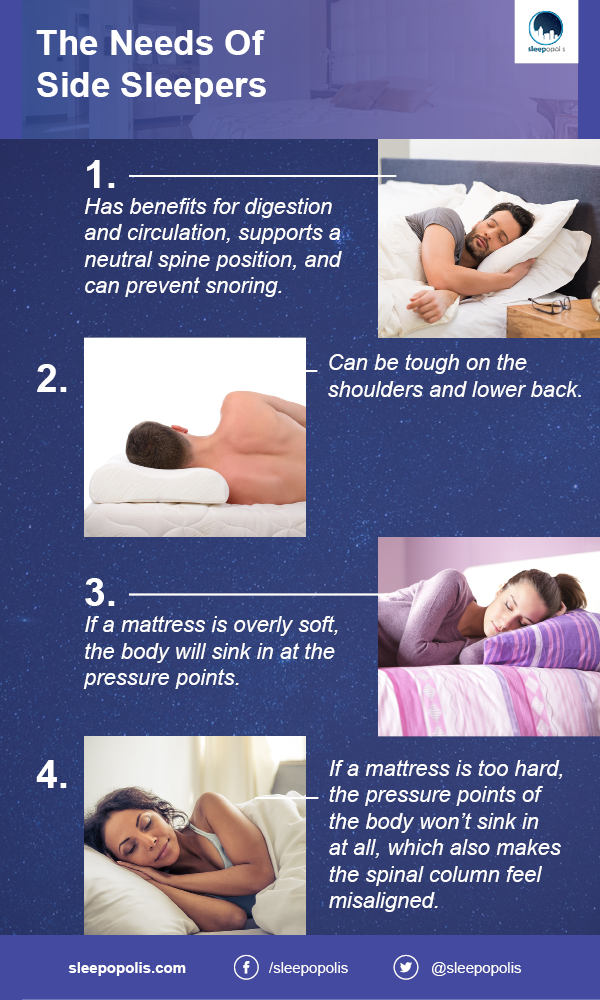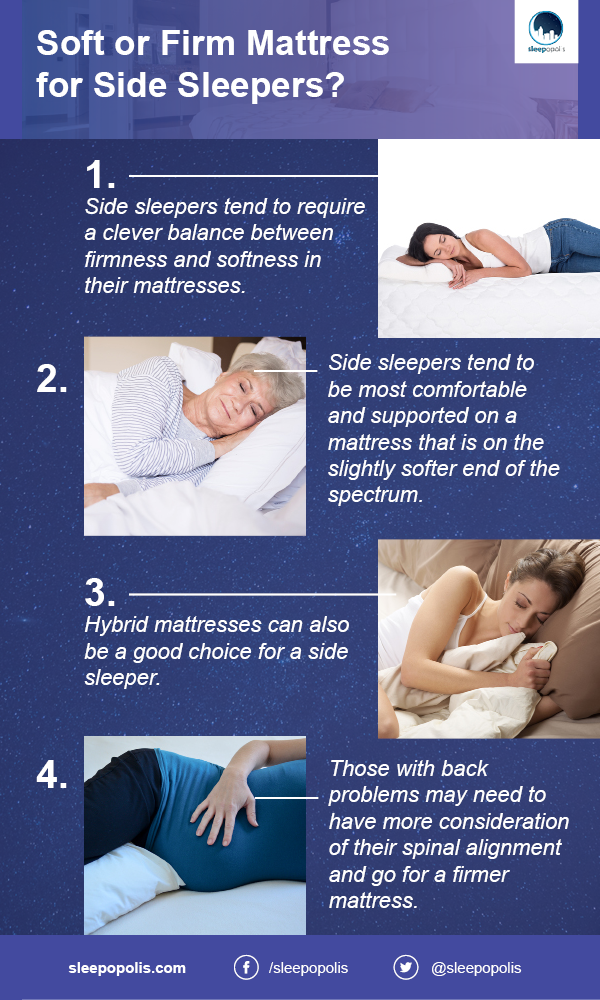Choosing the right mattress is a key part of getting the best possible night’s sleep. And no factor makes more difference to the feel of your bed and the quality of your sleep than the firmness or softness of your mattress.
Yet no one set firmness is ideal for everyone. There are multiple factors which affect the ideal feel of your bed. And a really important one is your sleeping position. So, which mattress type is best for those who sleep on their side? Read on to find out.
The Needs Of Side Sleepers

Side sleeping is a very popular sleeping position. It has benefits for digestion and circulation, supports a neutral spine position, and can prevent snoring. But side sleeping can be tough on the shoulders and lower back, and can result in problems with pelvic rotation.
Because the side of the body is more curved than the front or back, there is more potential for uncomfortable tension to build up during the night. Pain in shoulders and hips can be common, particularly if the mattress isn’t providing the right balance of comfort and support.
If a mattress is overly soft, the body will sink in at the pressure points – for side sleepers, this is the hip and shoulder. The spinal column between these pressure points can thus feel misaligned. However, if a mattress is too hard, the pressure points of the body won’t sink in at all, which also makes the spinal column feel misaligned. Finding the balance between softness and firmness is the best way to evenly spread the pressure and align the spine.
Another issue side sleepers face is the dreaded numb arm. This too can be mitigated by finding the correct mattress for you.
Benefits Of A Softer Mattress for Side Sleepers
A softer mattress may feel more initially comfortable to those who sleep on their sides. It will also provide more sinkage to the pressure points of the body during side sleep – notably the shoulder and hips, which will bear the brunt of the body weight. A softer mattress will also allow for more even pressure spread between shoulders and hips, with neither sinking lower than the other. This supports a neutral spine position, and lessens the potential for pain in the shoulders or pelvis come morning.
Drawbacks Of A Softer Mattress for Side Sleepers
An overly soft mattress can mean lack of support for the body, causing the back to “collapse”. This can mean waking up with shoulder, neck or back pain. A soft mattress can also make it more difficult to change positions during the night, which can be problematic for side sleepers who like to switch from side to side. This can also pose a problem to combo sleepers – those who spend some time on their sides, and some time on their front or back. Being trapped in one position over the course of a night can also make it more likely you’ll get a numb or dead feeling arm.

Benefits Of A Firmer Mattress
A firmer mattress offers more intense support to the natural contours of the body. It’ll most likely result in less neck, shoulder and back pain, and can even be used to treat ongoing back problems. On a firmer mattress, your bones bear the weight of the body, allowing muscles and blood vessels to relax. Firmer mattresses are also better for resistance, meaning changing position during the night can be easier.
Firmer mattresses also tend to be more durable than their softer counterparts. This is particularly important for side sleepers, as their sleeping position can wear out a mattress more quickly.
Drawbacks Of A Firmer Mattress
A very firm mattress can initially feel quite uncomfortable, particularly for a side sleeper. This is because the shoulders and hips won’t sink in to a comfortable level, and the body may feel poorly aligned or slightly contorted. A firm mattress can result in the hips sinking lower than the shoulders, making the spine feel bent. Generally speaking, a side sleeper needs more softness in their mattress than those who sleep on their front or back.
So Which Is Better for Side Sleepers?
Side sleepers tend to require a clever balance between firmness and softness in their mattresses. Too soft, and they’re liable to get back pain, but too firm and they’ll likely feel very uncomfortable during the night.
Side sleepers tend to be most comfortable and supported on a mattress that is on the slightly softer end of the spectrum. But a mattress without any firmness at all will leave them without any support for their back, shoulder and pelvis.
There are other factors to take into consideration on top of sleeping position when choosing a soft or a firm mattress. Weight is one: a heavier person will likely require a firmer mattress in order to adequately support their pressure. A lighter person will be more likely to be comfortable on a softer mattress with more give. Those with back problems may need to have more consideration of their spinal alignment, and go for a firmer mattress.
Best Mattress Materials For Side Sleepers
Memory foam or latex are popular options for those who sleep on their side. This is because it provides a better level of “give” than an innerspring mattress, while still offering enough support. Memory foam is particularly strong at pressure point relief and supporting spinal alignment, which are key factors in comfort and back health for side sleepers.
Hybrid mattresses can also be a good choice for a side sleeper. This is because they combine the supportive core of springs with a comfort layer, usually of a type of foam. Hybrid mattresses give the feel of a softer mattress, which can be more comfortable, alongside the support of an innerspring mattress, which can help with back and joint pain.
For more in-depth mattress reviews, check out the Sleepopolis review page here.